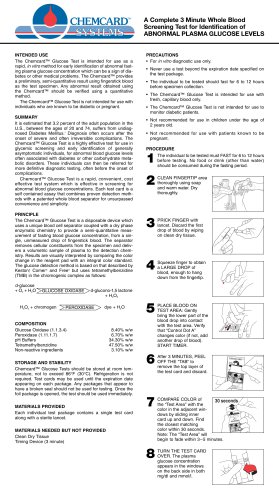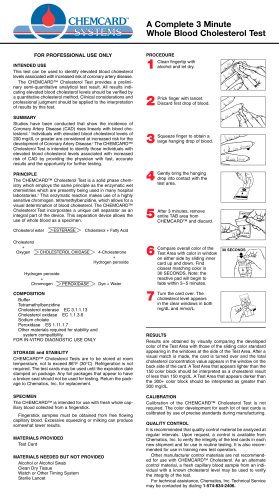
Catalog excerpts

A Complete 3 Minute Whole Blood Screening Test for Identification of ABNORMAL PLASMA GLUCOSE LEVELS INTENDED USE The Chemcard™ Glucose Test is intended for use as a rapid, in vitro method for early identification of abnormal fasting plasma glucose concentration which can be a sign of diabetes or other medical problems. The Chemcard™ provides a preliminary, semi-quantitative result using fingerstick blood as the test specimen. Any abnormal result obtained using the Chemcard™ should be verified using a quantitative method. The Chemcard™ Glucose Test is not intended for use with individuals who are known to be diabetic or pregnant. SUMMARY It is estimated that 3.2 percent of the adult population in the U.S., between the ages of 20 and 74, suffers from undiagnosed Diabetes Mellitus.1 Diagnosis often occurs after the onset of severe and often irreversible complications. The Chemcard™ Glucose Test is a highly effective test for use in glycemic screening and early identification of generally asymptomatic individuals, for abnormal blood glucose levels often associated with diabetes or other carbohydrate metabolic disorders. These individuals can then be referred for more definitive diagnostic testing, often before the onset of complications. Chemcard™ Glucose Test is a rapid, convenient, cost effective test system which is effective in screening for abnormal blood glucose concentrations. Each test card is a self contained assay that combines proven detection methods with a patented whole blood separator for unsurpassed convenience and simplicity. GLUCOSE OXIDASE • Never use a test beyond the expiration date specified on the test package. • The individual to be tested should fast for 6 to 12 hours before specimen collection. • The Chemcard™ Glucose Test is intended for use with fresh, capillary blood only. • The Chemcard™ Glucose Test is not intended for use to monitor diabetic patients. • Not recommended for use in children under the age of 2 years old. • Not recommended for use with patients known to be pregnant. PROCEDURE The individual to be tested must FAST for 6 to 12 hours before testing. No food or drink (other than water) should be consumed during the fasting period. CLEAN FINGERTIP area thoroughly using soap and warm water. Dry thoroughly. PRICK FINGER with lancet. Discard the first drop of blood by wiping on clean dry tissue. Squeeze finger to obtain a LARGE DROP of blood, enough to hang down from the fingertip. PRINCIPLE The Chemcard™ Glucose Test is a disposable device which uses a unique blood cell separator coupled with a dry phase enzymatic chemistry to provide a semi-quantitative measurement of fasting blood glucose concentration, from a single, unmeasured drop of fingerstick blood. The separator removes cellular constituents from the specimen and delivers a volumetric sample of plasma to the detection chemistry. Results are visually interpreted by comparing the color change in the reagent pad with an integral color standard. The glucose detection method is based on that described by 2 Keston, Comer 3 and Free4 but uses tetramethylbenzidine (TMB) in the chromogenic complex as follows: d-glucose + O2 + H2O PRECAUTIONS • For in vitro diagnostic use only. PLACE BLOOD ON TEST AREA: Gently bring the lower part of the blood drop into contact with the test area. Verify that “Control Dot A” changes color (if not, add another drop of blood). START TIMER. After 3 MINUTES, PEEL OFF THE “TAB” to remove the top layer of the test card and discard. COMPARE COLOR of 30 seconds the “Test Area” with the color in the adjacent windows by sliding inner card up and down. Find the closest matching color within 30 seconds. Note: The “Test Area” will begin to fade within 3–5 minutes. TURN THE TEST CARD OVER. The plasma glucose concentration appears in the windows on the back side in both mg/dl and mmol/l. COMPOSITION Glucose Oxidase (1.1.3.4) Peroxidase (1.11.1.7) pH Buffers Tetramethylbenzidine Non-reactive ingredients STORAGE AND STABILITY Chemcard™ Glucose Tests should be stored at room temperature, not to exceed 86°F (30°C). Refrigeration is not required. Test cards may be used until the expiration date appearing on each package. Any packages that appear to have a broken seal should not be used for testing. Once the foil package is opened, the test should be used immediately. MATERIALS PROVIDED Each individual test package contains a single test card along with a sterile lancet. MATERIALS NEEDED
Open the catalog to page 1
RESULTS Semi-quantitative plasma glucose concentration values are obtained by visual comparison of the reagent pad with the sliding color chart, then turning the test card over and reading the glucose level from the windows on the back. A reagent pad which appears lighter than the 50 mg/dl color block should be interpreted as being less than 50 mg/dl (2.8 mmol/l). A reagent pad which appears darker than the 150+ color block should be interpreted as being higher than 150 mg/dl (8.3 mmol/l). Chemcard results of 50 mg/dl (2.8 mmol/l) or less are considered abnormally low. Chemcard results of...
Open the catalog to page 2All Chematics catalogs and technical brochures
-
Alco-Screen™ 02
1 Pages
-
Alco-Screen™
1 Pages





